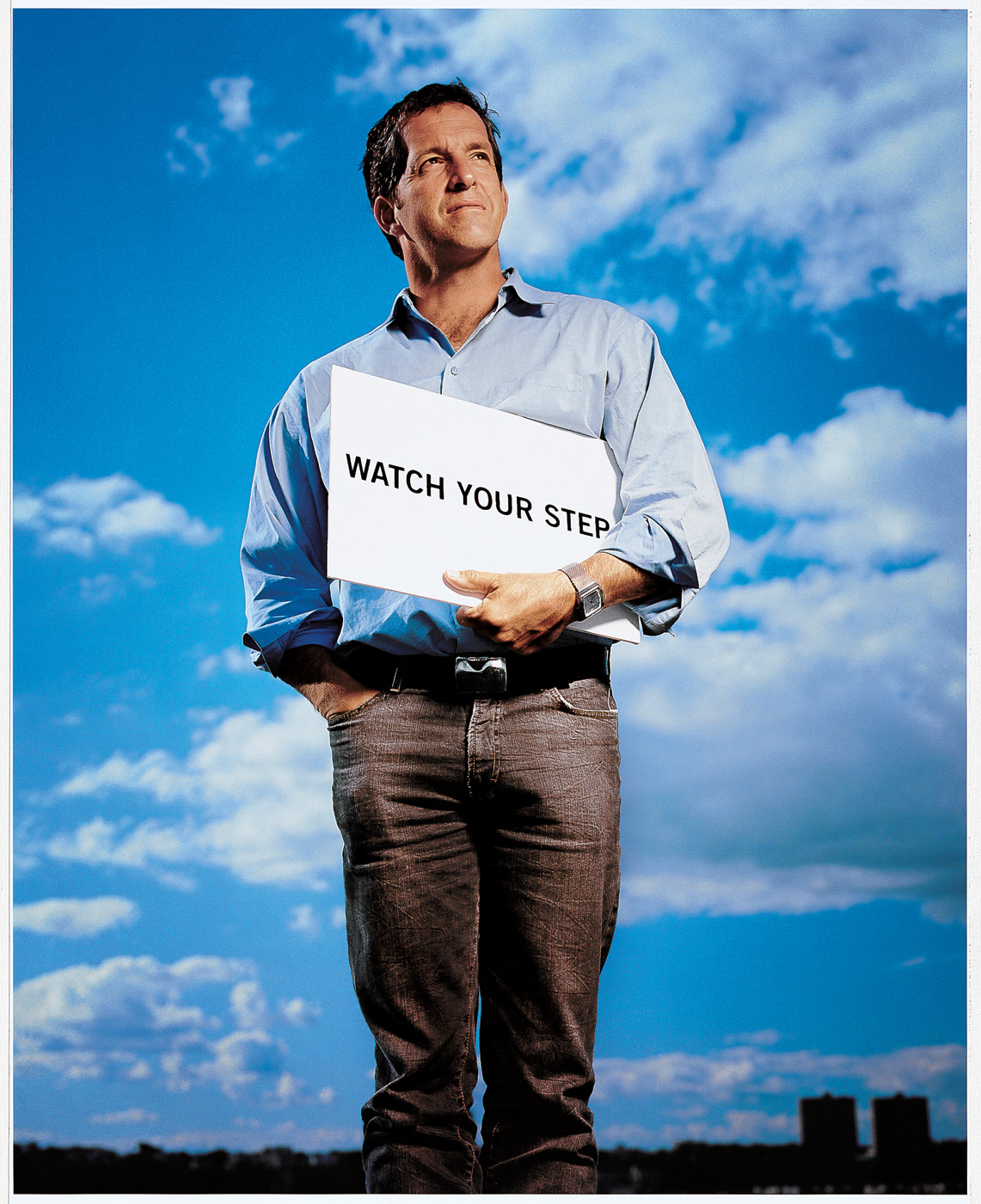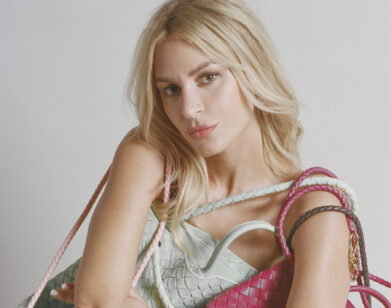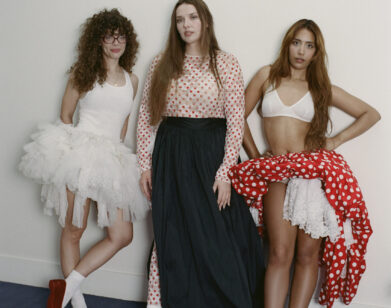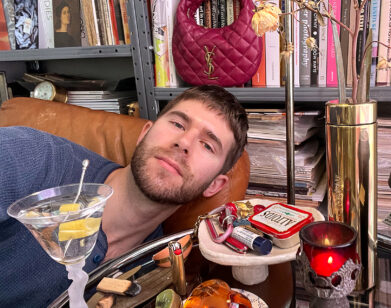Kenneth Cole

Kenneth Cole wears clothes and accessories by KENNETHâ??COLE NEW YORK. Styling: JOANNA JACOVINI. Grooming: JUSTINâ??CRUZ/Adir. JOSEPHâ??CULTICE.
How to succeed at designing clothes and redesigning the status quo. Artist Barbara Kruger, a seer when it comes to words and images, talks to the man who uses them brilliantly.
Barbara Kruger: I thought I would start our conversation by running something by you that you were quoted as saying once-that how a person looks is a self-fulfilling proph-ecy. This, to me, is a more complex take on how we put ourselves together than most things said about fashion. Can you explain what you meant?
Kenneth Cole: When you wake up in the morning, you’re relatively objective about what the day has in store for you-sometimes you’re more apprehensive, sometimes you’re more opti-
mistic, sometimes you’re less. But as you’re getting dressed, if you look in the mirror and you think that you look great, then you’re going to be as good as you can be. But if you think you look clumsy or awkward, you might as well just go out and get hit by a car, because you don’t have a chance. In other words, how you see yourself is the way you’ll end up being. Not taking those few moments in the morning to decide what you’re saying to people by how you’re choosing to dress is a lost opportunity. Of course, if you’re homeless or you can’t afford to feed yourself, you’re not going to be all that concerned about what you look like.
BK: You seem to understand fashion instrumentally, to grasp what it can and cannot do. How did you develop that ability?
KC: I don’t know. “Fashion” is an odd word because it means lots of different things to different people. To me, it’s kind of a relationship or a way of reflecting how an individual perceives their universe-it’s a way we all have of making a statement to the world. I’ve always believed that fashion is not just what you look like on the outside, it’s a reflection of who you are on the inside. To design from that place means essentially putting myself in your proverbial shoes so that I can somehow get a sense of where you are.
BK: But when an individual begins getting dressed, is that really an unedited process? Don’t we have a million voices in our heads telling us what works and what’s in?
KC: Yeah, but we edit those voices, and we hang on to the ones we choose to-you can reform or rebel. We certainly know what’s expected of us, but we have a sense of how to apply those rules. It’s up to each of us individually if we want to play the game or not.
BK: You’ve called yourself a right-brain/left-brain person, someone who tries to combine the artistic and the analytical simultaneously. Can you talk about that?
KC: Well, it’s hard to succeed in this business without having a full sense of not just the art but the process, so that’s where the right-brain/left-brain thing comes into play. You almost need one to be effective with the other, but it’s not something you can predetermine or work on necessarily-it’s more intuitive than that. There are probably people out there who are better at the analytical side than I am, just as there are one who are better on the creative side, but my ability to keep them both in check has worked to my benefit.
BK: To mark the 20th anniversary of your company, which began last fall, you published a book, Footnotes: What You Stand For Is More Important Than What You Stand In [Simon & Schuster]. It features a number of your campaigns, as well as your recollections about the evolution of your company over the past 20 years. One section that I found particularly interesting dealt with the launch of your brand-a big step for anyone. Did you ever have any doubts?
KC: I took a pretty big chance leaving a family business and a comfortable position, plus I was relatively young-this was 20 years ago, so I was just 11 at the time. [laughs] But at the risk of sounding arrogant and maybe deluded, I never considered the possibility that it wouldn’t work. In my mind I knew it would and didn’t ponder the alternative.
BK: How would you describe your approach to design?
Kenneth Cole wears clothes and accessories by KENNETHâ??COLE NEW YORK. Styling: JOANNA JACOVINI. Grooming: JUSTINâ??CRUZ/Adir. JOSEPHâ??CULTICE.
KC: I’m a pragmatist, and I don’t like gratuitous fashion-in fact, there’s not that much gratuitous anything in my life. I like things that work and that are comfortable and easy and sensible and practical: That’s what fashion is for me, and what I try to keep in mind when designing for both men and women.
BK: Here’s a basic question: What about the popularity of black clothes?
KC: [laughs] I love black. Anything black transforms lives in a profound way, particularly for women. For years women deliberated endlessly every morning, every afternoon, every night about what to wear, and about what works with what. It was a very difficult, tedious process. In fact, therapists everywhere were thriving as a result of this.
BK: [laughs] And wearing black.
KC: Exactly! And then about 10 or so years ago something happened that totally transformed people’s lives: black clothing. It simplified everything and took getting dressed in the morning from a process that required 2 hours to one that took just 10 minutes. Now you can wear something during the day that will work equally well at night, and that will look just as good from one season to the next. Black is slimming, it’s comfortable, and if you’re at work and someone you know dies, you don’t have to go home and change! It’s very practical.
Humor is vital. And hopefully it makes you feel better about yourself. Humor helps to get through some of the very difficult traumas we deal with every day.Kenneth Cole
BK: You’ve noted a similarity between de-signers and politicians. Can you explain?
KC: I think all designers have an agenda and a message they want to share. We need to communicate that message the best way we can, which is not that different from what a politician has to do. If a designer succeeds at delivering his or her message effectively, they get the chance to do it again next season, in much the same way as a politician.
BK: What made you decide to bring the issue of social responsibility into your ad campaigns?
KC: Fashion has always been viewed as frivolous, which is a position I’ve never accepted. I think if anything, fashion is a reflection of who we are individually as well as collectively. If I’m able to speak to the whole person and not just how they manifest themselves physically, that’s an extraordinary opportunity and a privilege to take on. This all started for me years ago with the issue of AIDS awareness. It was 1985, and no-
body was talking about the disease-Ronald Reagan hardly mentioned it during his entire presidency-though it clearly needed to be talked about, as it had the potential to devastate all our communities. It presented an incredible opportunity to say something meaningful. I guess in some ways I heightened people’s attention with the campaign I ran, just as I probably burdened some others with my perspective. But at the end of the day it had the effect of elevating my relationship with consumers, and as a result those relationships are far more substantive than they could have been otherwise.
BK: This approach has been mainstreamed throughout the fashion business now, but at the time you were really taking a chance.
KC: People say to me sometimes that I was one of the first to do “cause-related” marketing, which always makes me shudder-so much so that I’ll either respectfully change the subject or try to explain that it isn’t marketing as far as I’m concerned. From the outset I’ve been conscious about embedding this approach in the culture of the company; in 18 years we haven’t missed an opportunity to talk about AIDS awareness, we haven’t missed a World AIDS Day, we haven’t missed an AIDS walk, or many other social issues.
BK: Early on you worked with an ad agency, but later decided to create all the advertising in-house. Why the switch?
KC: At the very beginning, working with an advertising agency was a good experience, but at a certain point it became hard because it wasn’t collaborative enough. If advertising is to really work for a company like ours, the creative message needs to be one with the delivery of the message, as well as the product and everything else the company stands for. So, by moving the advertising in-house, we could marry it with the other energy and resources internally and make it a little more collaborative throughout the company.
BK: You often assume a very provocative position in your advertising, yet it always seems to have a degree of humility.
KC: I believe in perspective, the idea that it’s the way you look at things-what your expectations are and how you perceive them-that determines their outcome.
BK: Humor also seems to play a big part in your campaigns. What role does it play in your work and everyday life?
KC: Humor is vital. I think it helps us stay grounded and reminds us to keep our work in perspective. And hopefully it makes you feel better about yourself. So I think it’s important that we continue to remind ourselves of that and that we continue to laugh and make light of this process. Humor helps to get through some of the very difficult traumas we deal with every day. And by integrating it, it becomes much more fruitful and more real.
BK: You’ve talked before about asking yourself why you do what you do, why you’re still doing it, and what “it” is. What kind of answers have you come up with?
KC: I do this work because I love it. And I do believe on some level that I’m having an impact on individuals if only in a superficial way. Being a part of this important decision people make every morning as to how they’re going to present themselves is an incredible privilege-it’s an extraordinary compliment, and it’s one I hope to be able to earn for another 20 years and to marry that work with my other social priorities. It’s kind of a “one plus one equals three and sometimes four” scenario for me. Achieve that and I will have gone above and beyond anything I could have hoped for.






